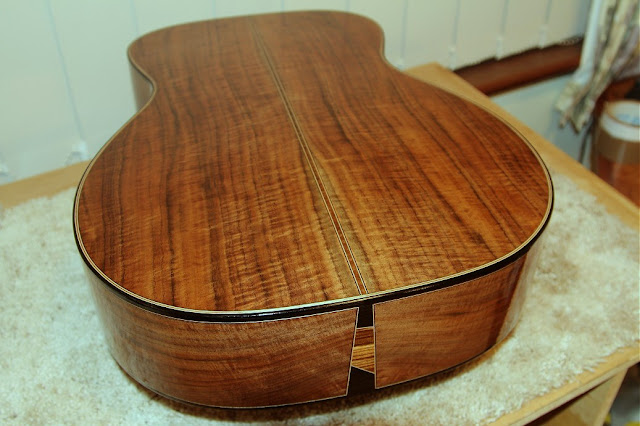There are a multitude of guitar finish products available, and it's generally acknowledged that each of them have their advantages as well as their shortcomings. The dilemma for the guitar builder, then, is in deciding which particular compromise they can live with, and what product best suits their particular circumstances.
My current choice is Grafted Coatings' KTM-SV, a water-based, oil-modified urethane that a growing number of musical instrument makers are using with great success. I'm in the throes of completing the guitar pictured - my third using KTM-SV. Although I've been pleased with this product so far, if a little of its flexibility could be sacrificed for the sake of hardness, I'd be truly ecstatic. I'm keeping an eye out for the release of the manufacturer's new product - which I believe will be marketed as KTM-10 - in the hope that it makes up for what KTM-SV lacks in terms of hardness. Early reports sound very encouraging.
My technique with the spray gun tends to improve over the course of finishing a guitar, and by the time I've applied the last of the top coats, I've generally sorted myself and the gun out to the extent that the guitar's finish is level and reasonably smooth. After the finish has cured for a few days, the process of sanding through the grades of sandpaper can proceed. With the paper wrapped around a cork block, I begin sanding with 600 or 800 grit paper, depending on the quality of my last coat. I'm pretty cautious when sanding the edges of the body and the headstock; I skip the coarser grades and begin my sanding of those areas with 1200 grit paper, dispensing with the sanding block. I use soapy water as a lubricant throughout this process, and constantly check my progress by squeegeeing off the water and holding the body or neck up the the light to check for rogue sanding scratches.

Inevitably, I'll sand through the topmost finish coat to one or more of the underlying coats; witness lines are evidence of that, even after a thorough sanding with the finest of the papers. It's at this point, of course, that my attention turns to the buffing wheel, but I've learned that this finish needs a couple of weeks to harden enough that buffing will completely remove these witness lines. I've wasted a lot of time and effort and become quite frustrated when attempting to achieve a mirror-like gloss before the finish has had time to harden - it's just not going to happen! Not unexpectedly, it's also apparent that the finish shrinks ever so slightly over the first few weeks. On future guitars, I plan to delay sanding with 1500 and 2000 grit papers - if not all of them - until a couple of weeks has elapsed and I'm about to buff. Perhaps that's not so much of a consideration where the soundboard is concerned as ridges in the finish corresponding to grain lines seem to be accepted, given their inevitability when any of the more traditional nitrocellulose lacquers are used.
Links to Grafted Coatings' web site:
KTM-SV
KTM-10
To view previous posts dealing with KTM-SV, click
here.
Cheers
Pete























